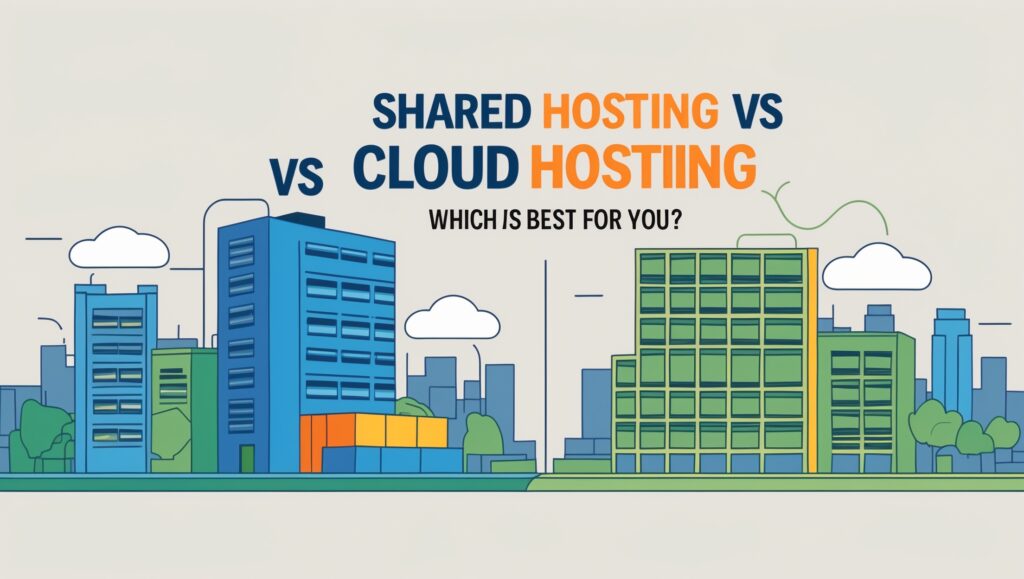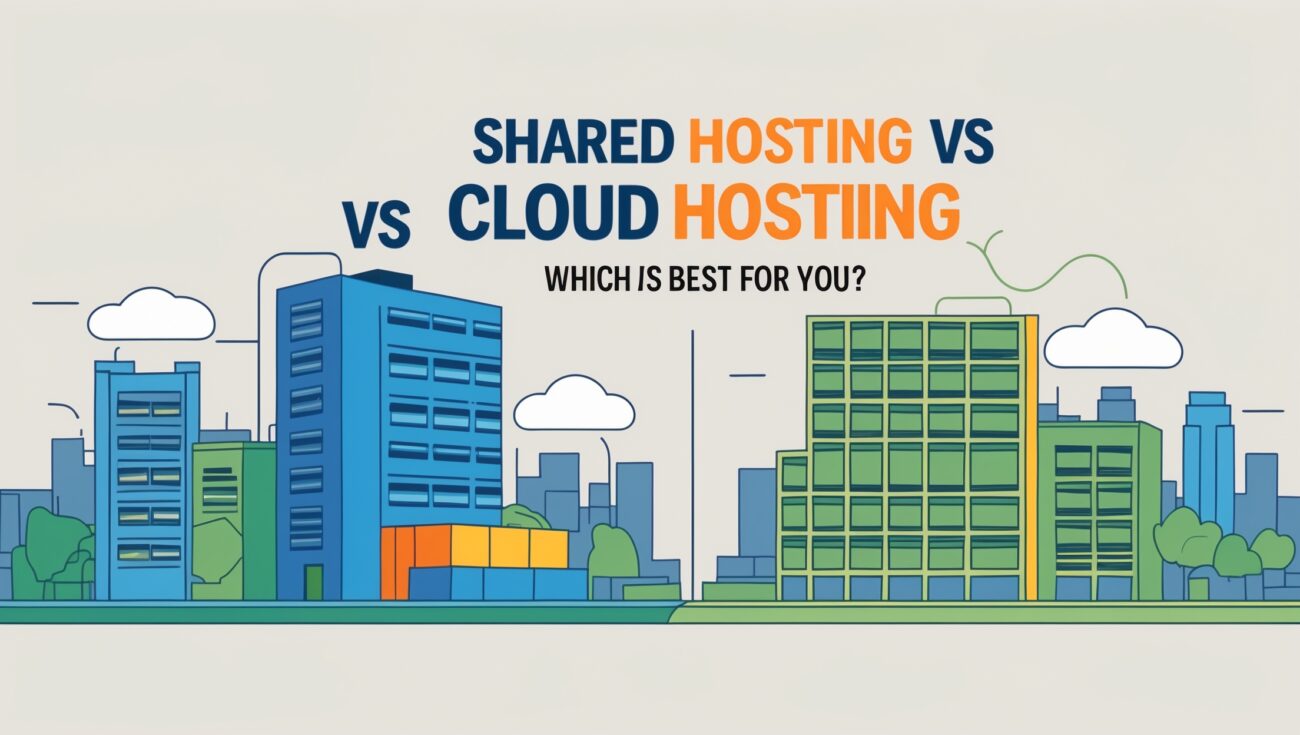Shared Hosting vs. Cloud Hosting: Which Is Best for You?
Confused between shared hosting and cloud hosting? Learn how I chose the perfect hosting type for my website, improved performance, and saved money while scaling smoothly.

Table of Contents
Cloud Hosting vs Shared Hosting: What’s the Real Difference?
When I first started learning about hosting, I kept seeing terms like cloud hosting and shared hosting, and honestly, it felt confusing. They both host your website — but how they work and what you get are completely different. If you’ve ever searched for “cloud hosting vs shared hosting” or “shared hosting vs cloud hosting”, here’s the simple explanation I wish I had from day one.
Shared hosting means your website shares a single physical server with other websites. It’s affordable, beginner-friendly, and perfect for small blogs or new projects. But because you share resources (like CPU and RAM) with other users, if one site gets a sudden traffic spike, it can slow down yours.
Cloud hosting, on the other hand, is like having access to multiple servers at once. Instead of relying on a single machine, your site is hosted on a network of connected servers — also called the “cloud.” That’s why cloud hosting is faster, more reliable, and scales easily as your site grows.
In short, the difference between cloud hosting and shared hosting comes down to flexibility and performance. Shared hosting is cheaper and great for beginners. Cloud hosting is more powerful and ideal for growing websites or businesses that can’t afford downtime.
If you’re still not sure which to choose, I’ve personally found SiteGround offers the best of both worlds. Their cloud hosting shared environment starts small but can scale instantly when you need more power — no migrations, no stress. It’s designed for creators like me who want something easy to manage but strong enough to handle growth.
When comparing shared vs cloud hosting, think of it like public transport vs a private car. Shared hosting is like taking the bus — affordable and gets the job done. Cloud hosting is like having your own car — faster, more comfortable, and customized to your needs.
For most beginners, starting with shared hosting is perfectly fine. But if you plan to grow, switch to SiteGround Cloud Hosting early. You’ll immediately notice faster load times, stronger uptime, and overall better stability for your website.
Whether you call it cloud hosting shared or shared vs cloud hosting, understanding the difference helps you make a smarter decision — one that saves time, money, and frustration in the long run.
Hosting Choices Can Be Overwhelming
When I first started my website, I had no idea about hosting types. The choices were overwhelming: shared hosting, cloud hosting, VPS, dedicated servers… I quickly realized that choosing the wrong host can slow down your site, hurt SEO, and make your life harder.
I learned that understanding the differences between shared hosting vs. cloud hosting was key. The right hosting choice depends on your website’s size, traffic, and growth goals.
In this post, I’ll walk you through how I evaluated shared and cloud hosting, what I recommend for beginners versus growing websites, and how you can make the best choice without overspending.
If you want a reliable hosting provider for both shared and cloud hosting, check out SiteGround.
Step 1: What Is Shared Hosting?
Shared hosting is exactly what it sounds like—you share a server with other websites. Each site has limited resources like CPU, RAM, and storage.
Advantages of shared hosting:
- Affordable: Great for beginners or small blogs
- Easy setup: Usually comes with one-click installs for WordPress and other CMS
- Maintenance handled: The host manages server security and updates
Drawbacks of shared hosting:
- Limited resources: High traffic on other sites can slow your website
- Less control: Advanced server configuration is limited
- Scalability issues: May need to upgrade as your site grows
I started my first blog on SiteGround shared hosting, and it was perfect for getting started—fast, reliable, and beginner-friendly.
Check SiteGround shared hosting here
Step 2: What Is Cloud Hosting?
Cloud hosting uses a network of servers rather than a single physical server. Your website pulls resources from multiple servers, ensuring better performance and uptime.
Advantages of cloud hosting:
- Scalable resources: Handles traffic spikes easily
- High reliability: If one server fails, another takes over
- Better performance: More resources and faster load times
Drawbacks of cloud hosting:
- Higher cost: More expensive than shared hosting
- More complex setup: May require technical knowledge
I moved to SiteGround’s cloud hosting when my traffic grew, and the difference was incredible—faster load times, improved uptime, and smoother user experience.
See SiteGround cloud hosting here
Step 3: Cost Comparison
When I compared prices, shared hosting was much cheaper upfront. This is ideal if:
- You’re just starting
- Your site has low traffic
- You want to test ideas without heavy investment
Cloud hosting costs more, but it’s worth it if:
- Your site is growing quickly
- You expect traffic spikes
- You want top-tier performance and uptime
I personally started with shared hosting and upgraded to cloud when my site needed it—a perfect balance of cost and performance.
Step 4: Performance and Speed
Speed is critical for SEO and user experience. Here’s what I learned:
- Shared hosting: Sufficient for small websites, but speed can fluctuate based on other sites on the server
- Cloud hosting: Provides dedicated resources, ensuring consistent high speed
Using SiteGround, I noticed 50% faster page loads when upgrading to cloud hosting, which helped reduce bounce rates and improve rankings.
Step 5: Reliability and Uptime
Nothing frustrates visitors more than a website that’s down.
- Shared hosting: Reliable but can experience downtime if another site on the server causes issues
- Cloud hosting: Almost no downtime because resources are distributed across multiple servers
I personally value uptime highly. Moving to cloud hosting gave me peace of mind knowing my site was always available.
Step 6: Security Considerations
Security is a priority for me. Here’s what I observed:
- Shared hosting: Security is decent, but shared resources can be a vulnerability if other sites are hacked
- Cloud hosting: More secure because resources are isolated and better protected
SiteGround offers built-in security features for both hosting types, including:
- Free SSL certificates
- Web Application Firewall (WAF)
- Daily backups
- AI anti-bot protection
This ensures my sites are safe no matter which hosting type I choose.
Secure hosting with SiteGround here
Step 7: Scalability
One key difference is scalability:
- Shared hosting: Limited ability to scale; may require migration to a better plan
- Cloud hosting: Highly scalable; can handle growing traffic instantly
I recommend starting small with shared hosting, then upgrading to cloud hosting when traffic and resource needs increase.
Step 8: Who Should Use Shared Hosting?
Shared hosting is perfect if you are:
- A beginner blogger or small business owner
- Budget-conscious
- Running a site with low to moderate traffic
- Looking for simple setup and easy maintenance
SiteGround makes shared hosting fast, secure, and beginner-friendly, so you can focus on content instead of technical issues.
Start with SiteGround shared hosting
Step 9: Who Should Use Cloud Hosting?
Cloud hosting is ideal if you are:
- Running high-traffic blogs, e-commerce stores, or membership sites
- Expecting traffic spikes from marketing campaigns
- Wanting maximum uptime and performance
I upgraded to cloud hosting as my audience grew, and it allowed me to handle more visitors without worry.
Explore SiteGround cloud hosting
Step 10: Common Mistakes to Avoid
- Choosing hosting based solely on price
- Ignoring site speed and performance
- Not considering future growth and scalability
- Skipping security features
- Overcomplicating your setup as a beginner
By avoiding these mistakes, I ensured my website was fast, secure, and scalable from day one.
FAQ
Q: Can I start with shared hosting and upgrade to cloud?
Yes! SiteGround makes it simple to upgrade without downtime.
Q: Is cloud hosting necessary for a new blog?
Not usually. Shared hosting is sufficient for most beginners. Upgrade as your site grows.
Q: Which hosting is better for SEO?
Both can be optimized for SEO, but faster, reliable cloud hosting may provide an edge for high-traffic sites.
Conclusion
Choosing between shared hosting and cloud hosting depends on your website’s needs, budget, and growth plans.
I started my first site on shared hosting with SiteGround—affordable, reliable, and beginner-friendly. As my traffic grew, I upgraded to cloud hosting for speed, uptime, and scalability.
Whether you’re starting small or planning for growth, SiteGround has plans that fit every stage of your website journey.

